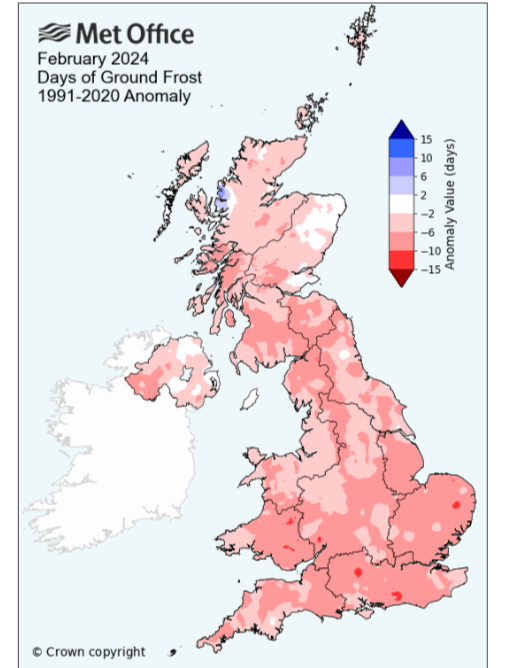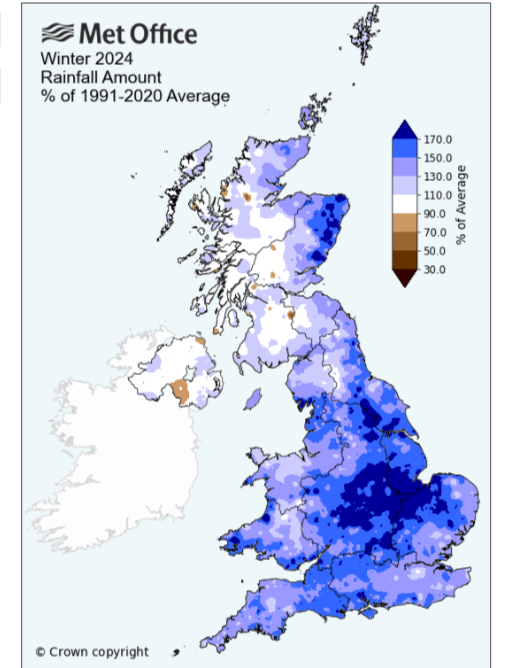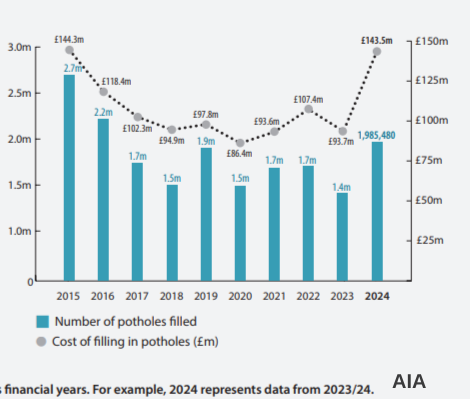
The UK climate demands a lot of our road surfaces: it becomes increasingly hot in summer and floods in winter. Even without a hard cold winter, the rain has added to pothole problems.
Complaints about potholes rage on. Filling politicians' inboxes, as social media rantings and correspondence to local councils increase. There are many factors around why the roads are in such a state but the UK weather is not helping.
It’s been so wet in parts of Britain that many potholes are probably submerged and out of sight. Usually in winter, it is the frost and ice which make the road situation even worse but this winter has been milder than average overall. It has also been very wet. Early December and mid-January saw wintry spells with hard frosts, then it became much milder and wetter.

Fewer days with ground frost than average
“For England and Wales combined, this was the second warmest winter on record, just behind 2016. The UK provisionally recorded…the eighth-wettest winter. “ Met Office
“February was a very wet month across the southern half of the UK which received more than twice the average rainfall widely, for some locations more than three times. Southern England…it was the wettest February on record.” Met Office

Some parts of the UK have had a very wet winter overall, others a record-breaking wet February.
Fixing roads costs money. The AIA, Asphalt Industry Alliance issued it's Annual Local Authority Road Maintenance (ALARM) survey report, published on the 19th March 2024. This highlighted the scale of the challenge that local authority highway teams face who don’t have the funds to keep roads in good shape. It was southern England seeing the worst of the wet weather, with East Anglia recording its wettest and warmest February.
89% of London boroughs reported having to cope with unforeseen highway maintenance costs over the year. “The reasons identified for these include dealing with the effects of extreme weather events, rising traffic volumes and increased average vehicle weights on a deteriorating network, as well as the impact of inflation which has had a noticeable impact on costs.” AIA
For other regions, the lack of usual wintry weather was a bonus. In southeast Scotland, East Lothian Council said
“We have not experienced particularly prolonged periods of snow or ice in the recent winter…Observations from our Road Services team suggest that the nature of pothole damage is also similar to what has been seen in recent years, including when we have seen more prolonged periods of wintry conditions.”
There is a Pothole Fund in England, with road maintenance a devolved matter for Wales, Northern Ireland and Scotland. With rising inflation, the allocated funds don’t cover as much work or supplies. Rick Green, Chair of the AIA “Couple this with the effects of the extreme weather we are increasingly facing, and the result is that the rate at which local roads are suffering is accelerating towards breaking point.”
The problem with road surfaces is that when they are new and pristine they are less likely to develop potholes but as soon as a break appears in that surface, it grows and grows. So any weaknesses from vehicle damage, earlier repairs or weather effects enable further decay.
 Patching helps but many roads nationwide need major work. Some of that will be planned already causing inconvenience to drivers whereas other repairs are reactive as dangerous holes appear.
Patching helps but many roads nationwide need major work. Some of that will be planned already causing inconvenience to drivers whereas other repairs are reactive as dangerous holes appear.
“Inflation has eaten into councils’ maintenance budgets, meaning major resurfacing schemes designed to prevent more expensive repairs have had to be delayed or scaled back” AIA

UK roads need to cope with a range of weather conditions and temperatures. Asphalt roads have to be able to withstand temperatures from -20C to +60C. The busiest roads have Polymer modified binders added to cope with up to 80C, but this is expensive. In the height of summer as the dark road surface absorbs incoming solar radiation the asphalt can soften and become flexible.
Compare this to icy winter weather when temperatures fall below freezing and the surface becomes more brittle. Any cracks can fill with water which then freezes and the ice expands. This causes more damage to the surface, and larger cavities, then potholes as vehicles drive over the damage.
Waterlogging or fast-flowing streams that appear after heavy rain do not help either. The water infiltrates the road structure. It permeates cracks and joints weakening the underlayers. People will be swerving to avoid deep puddles and perhaps catch edges of road surfaces. Trying to avoid flood areas and the existing potholes. There is the obvious potential for damage to cars and other vehicles but they can be a lethal hazard for cyclists and motorcyclists.
“The risk posed to motorcyclists by poorly maintained road surfaces is very real, and one of the most cited safety concerns of the riding community. “ Motorbike Action Group
The sodden ground in England with standing water, mud and state of road surfaces must be offputting even if a dry, fine day appears.
Roads are constructed in layers, with the top layer being water-resistant and curved so that water drains away to the sides. Ironworks are a break in that surface. Gutters need to be clear to allow the runoff water to flow away easily. Water seeps into the asphalt and weakens the bond between the bitumen and the aggregate. It weakens and becomes more susceptible to damage. Cracks also appear due to heavy traffic and the changing seasonal temperatures. Even diurnal changes can be enough to impact the surface, from day to night. 'Freezing and thawing' is the main strain on roads in the winter but rain and flooding have impacts too. With intense rainfall and flash flooding, entire sections of roads can be washed away. Being in a good state to start with is very important but the AIA's ALARM report stated that a One-Time catchup would take 10 years to complete and cost £16.3 billion, covering England and Wales.
 Trying to fix potholes in winter is difficult. Ideally, you would want a dry surface otherwise the job will need to be done again pretty quickly.
Trying to fix potholes in winter is difficult. Ideally, you would want a dry surface otherwise the job will need to be done again pretty quickly.
“Adverse weather conditions, particularly wetter winters with more intense downpours and storms and hotter, drier summers, coupled with increased traffic volumes and the age of the network can result in accelerated deterioration and a cycle of reducing resilience.” AIA
The Met Office projects that due to the effects of climate change, in the future the UK will see:
Warmer and wetter winters - Hotter and drier summers - More frequent and intense weather extremes
All of these will impact our roads, The road network does need investment and funding. Maintenance is an issue, road surfaces have a set lifetime but the UK’s varied climate does add to the problems. The issue is that when road damage is not treated quickly it just gets worse. It’s not safe, there is travel disruption and it becomes more expensive to fix. It just needs to dry up first.